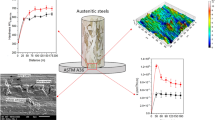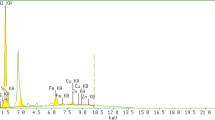The use of powder-cored wires as electrodes for electrospark deposition (ESD) of coatings onto quenched and low-tempered steel 45 was studied. An industrial PP-Np-PD80Kh20R3T powder-cored wire (PW) and a combined powder-cored wire with an MPG-7 graphite addition (PWG) were applied. The mechanical characteristics peculiar to the surface layer of electrospark-deposited coatings produced from the powder-cored wires (hardness HV, friction coefficient μ, elastic strain energy Aelast, and plastic strain energy Aplast) were quantified. The indenter loading and kinetic indentation depth curves were plotted. Variations in penetration depth Pd and recovery depth Rd of the indenter in scratch tests of the ESD coatings produced from the powder-cored wires were illustrated. Characteristic changes in the mechanical characteristics at a preset indenter penetration depth and the microstructure of the ESD powder-cored coatings subjected to scratch tests were examined. The wear rate of the ESD coatings deposited with PW and PWG electrodes was established as a function of specific loading, sliding speed, and testing time. Variations in roughness of the friction surfaces and temperatures in the contact area in dry sliding friction conditions were studied. The PWG coating showed 24% higher hardness than the PW coating did and 10% lower friction coefficient determined by indentation. The roughness of the PWG coating increased by 10% when loading changed from 3 to 7 MPa. The PWG coating (pin-on-disk friction test) had 2.5 times higher wear resistance than the PW coating did, and the disk (counterface) had 28% lower wear. A slight increase of temperature in the tribological contact area was not found to soften the coating or substrate (quenched and low-tempered steel 45) but promoted regeneration of the protective oxide layer and favorably influenced the friction process. Both materials produced from the powder-cored wires (PW and PWG) exhibited normal mechanochemical wear in experimental conditions. The high wear resistance of the ESD coatings produced from the powder-cored wires in dry friction conditions indicated that they would be beneficial for strengthening and improving the life of various machine parts and mechanisms in industrial mechanical engineering.







Similar content being viewed by others
References
M.I. Pashechko, V.M. Holubets, and M.V. Chernets, Deposition and Frictional Resistance of Eutectic Coatings [in Russian], Naukova Dumka, Kyiv (1993), p. 344.
V.M. Holubets, O.B. Gasiy, O.Y. Yuga, and O.V. Bilous, Iron-Based Eutectic Alloy for Deposition of Coatings [in Ukrainian], Declaration Patent 39481.A publ. June 15 (2001), Bulletin No. 5.
O.B. Gasiy, Development of Eutectic Electrodes for Electrospark Hardening of Machine and Equipment Parts [in Ukrainian], Author’s Abstract of PhD Thesis, Lviv (1993), p. 16.
V.M. Holubets and A.V. Paustovskii, “Electrospark deposition of a surface metal layer,” in: Scientific Papers, Mechanics (43), No. 216, ATR, Bydgoszcz (1998), pp. 265–273.
V.M. Holubets, O.V. Bilous, O.Y. Yuga, and O.B. Gasiy, “Effect of the type of the coating on the tribotechnical properties of cutting tools,” in: Scientific Bulletin, Prestizh Inform, Lviv (1999), No. 9.5, pp. 239–245.
M.I. Pashechko, “Wear resistance of eutectic coatings of the Fe–Mn–C–B system alloyed with Si, Ni, and Cr,” Mater. Sci., 46, No. 5, 695–701 (2011).
M.I. Pashechko, G.S. Ershov, K. Lenik, and N.A. Us’kova, “Eutectic-gradient wear resistance in materials,” Powder Metall. Met. Ceram., 38, No. 7–8, 340–343 (1999).
M. Pashechko and K. Lenik, “Segregation of atoms of the eutectic alloy Fe–Mn–C–B–Si–Ni–Cr at friction wear,” Wear, 267, Issues 5–8, 1301–1304 (2009).
M.I. Pashechko, K. Dziedzic, and M. Barszcz, “Study of the structure and properties of wear-resistant eutectic Fe–Mn–C–B–Si–Ni–Cr coatings,” Powder Metall. Met. Ceram., 52, No. 7–8. 469–476 (2013).
M. Paszeczko, K. Dziedzic, and M. Barszcz, “Study of coatings obtained from alloy Fe–Mn–C–B–Si–Ni–Cr,” Adv. Sci. Technol. Res. J., 10, No. 31, 194–198 (2016).
A.V. Paustovskii and V.P. Botvinko, “Effect of pulsed laser radiation on the structure and properties of electrospark coatings of types VK and TK alloys,” Powder Metall. Met. Ceram., 30, No. 2, 139–141 (1991).
M. Kindrachuk, A. Kryzhanovskyi, and A. Shevchenko, “Improvement of the quality of TiC–Co system plasma coating by laser treatment,” Aviation, 20(4), 155–159 (2016).
T. Cherepova, G. Dmitrieva, O. Tisov, O. Dukhota, and M. Kindrachuk, “Research on the properties of Co–TiC and Ni–TiC HIP-sintered alloys,” Acta Mech. Autom., 13, No. 1, 57–67 (2019).
A.A. Burkov, A.V. Zaitsev, A.V. Syui, E.R. Zaikova, and O.I. Kaminskii, “Corrosion, mechanical and catalytic properties of coatings based on FeNiCrWMoCoCB metallic glasses,” Prot. Met. Phys. Chem. Surf., 55, No. 1, 102–108 (2019).
I.S. Kuznetsov, A.V. Kolomeichenko, and V.Z. Pavlov, “Process of mass transfer of amorphous alloys under low-voltage electric spark treatment,” Surf. Eng. Appl. Electrochem., 53, No. 4, 333–338 (2017).
S.A. Pyachin and A.A. Burkov, “Formation of intermetallic coatings by electrospark deposition of titanium and aluminum on a steel substrate,” Surf. Eng. Appl. Electrochem., 5, No. 2, 118–124 (2015).
A.A. Burkov, E.R. Zaikova, and M.I. Dvornik, “Deposition of Ti–Ni–Zr–Mo–Al–C composite coatings on the Ti6Al4V alloy by electrospark alloying in a granule medium,” Surf. Eng. Appl. Electrochem., 54, No. 6, 546–554 (2018).
M.I. Pashechko and J. Montusiewicz, “Evaluation of the wear resistance of eutectic coatings of the Fe–Mn–C–B system alloyed by Si, Ni, and Cr using multi-criteria analysis,” Mater. Sci., 47, No. 6, 813–821 (2018).
V.M. Holubets, M.I. Pashechko, J. Borc, and M. Barszcz, “Micromechanical characteristics of the electrospark-deposited steel 45 surface layer,” Fiz..-Khim. Mech. Mater., 55, No. 3, 102–108 (2019).
V.M. Holubets, V.M. Dovgunik, M.I. Pashechko, S.A. Korniy, and Yu.S. Shpuliar, “Friction behavior of electrospark coatings in boundary lubrication conditions,” Fiz.-Khim. Mekh. Mater., 56, No. 1, 47–52 (2020).
M.V. Kindrachuk, V.F. Labunets, M.I. Pashechko, and E.V. Korbut, Tribology: Coursebook [in Ukrainian], Vyd. Nats. Aviat. Univ. NAU-Druk, Kyiv (2009), p. 392.
B.I. Kostetskii, Friction, Lubrication, and Wear in Machines [in Russian], Technika, Kyiv (1970), p. 395.
Author information
Authors and Affiliations
Corresponding author
Additional information
Translated from Poroshkova Metallurgiya, Vol. 60, Nos. 1–2 (537), pp. 113–120, 2021.
Rights and permissions
About this article
Cite this article
Holubets, V., Pashechko, M., Borc, J. et al. Wear Resistance of Electrospark-Deposited Coatings in Dry Sliding Friction Conditions. Powder Metall Met Ceram 60, 90–96 (2021). https://doi.org/10.1007/s11106-021-00218-0
Received:
Published:
Issue Date:
DOI: https://doi.org/10.1007/s11106-021-00218-0




